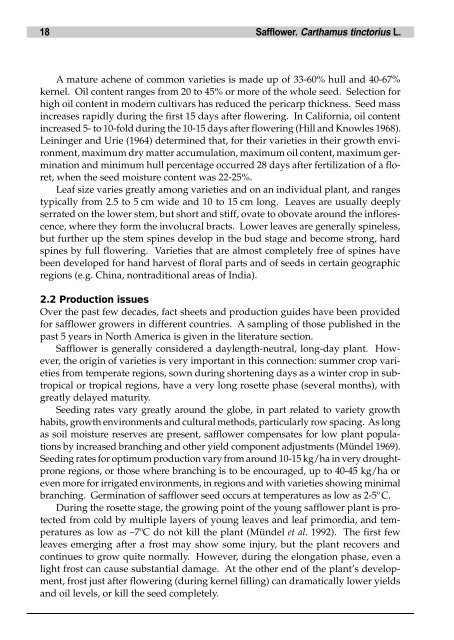Safflower, Carthamus tinctorius L. - Bioversity International
Safflower, Carthamus tinctorius L. - Bioversity International
Safflower, Carthamus tinctorius L. - Bioversity International
Create successful ePaper yourself
Turn your PDF publications into a flip-book with our unique Google optimized e-Paper software.
18 <strong>Safflower</strong>. <strong>Carthamus</strong> <strong>tinctorius</strong> L.<br />
A mature achene of common varieties is made up of 33-60% hull and 40-67%<br />
kernel. Oil content ranges from 20 to 45% or more of the whole seed. Selection for<br />
high oil content in modern cultivars has reduced the pericarp thickness. Seed mass<br />
increases rapidly during the first 15 days after flowering. In California, oil content<br />
increased 5- to 10-fold during the 10-15 days after flowering (Hill and Knowles 1968).<br />
Leininger and Urie (1964) determined that, for their varieties in their growth environment,<br />
maximum dry matter accumulation, maximum oil content, maximum germination<br />
and minimum hull percentage occurred 28 days after fertilization of a floret,<br />
when the seed moisture content was 22-25%.<br />
Leaf size varies greatly among varieties and on an individual plant, and ranges<br />
typically from 2.5 to 5 cm wide and 10 to 15 cm long. Leaves are usually deeply<br />
serrated on the lower stem, but short and stiff, ovate to obovate around the inflorescence,<br />
where they form the involucral bracts. Lower leaves are generally spineless,<br />
but further up the stem spines develop in the bud stage and become strong, hard<br />
spines by full flowering. Varieties that are almost completely free of spines have<br />
been developed for hand harvest of floral parts and of seeds in certain geographic<br />
regions (e.g. China, nontraditional areas of India).<br />
2.2 Production issues<br />
Over the past few decades, fact sheets and production guides have been provided<br />
for safflower growers in different countries. A sampling of those published in the<br />
past 5 years in North America is given in the literature section.<br />
<strong>Safflower</strong> is generally considered a daylength-neutral, long-day plant. However,<br />
the origin of varieties is very important in this connection: summer crop varieties<br />
from temperate regions, sown during shortening days as a winter crop in subtropical<br />
or tropical regions, have a very long rosette phase (several months), with<br />
greatly delayed maturity.<br />
Seeding rates vary greatly around the globe, in part related to variety growth<br />
habits, growth environments and cultural methods, particularly row spacing. As long<br />
as soil moisture reserves are present, safflower compensates for low plant populations<br />
by increased branching and other yield component adjustments (Mündel 1969).<br />
Seeding rates for optimum production vary from around 10-15 kg/ha in very droughtprone<br />
regions, or those where branching is to be encouraged, up to 40-45 kg/ha or<br />
even more for irrigated environments, in regions and with varieties showing minimal<br />
branching. Germination of safflower seed occurs at temperatures as low as 2-5º C.<br />
During the rosette stage, the growing point of the young safflower plant is protected<br />
from cold by multiple layers of young leaves and leaf primordia, and temperatures<br />
as low as –7ºC do not kill the plant (Mündel et al. 1992). The first few<br />
leaves emerging after a frost may show some injury, but the plant recovers and<br />
continues to grow quite normally. However, during the elongation phase, even a<br />
light frost can cause substantial damage. At the other end of the plant’s development,<br />
frost just after flowering (during kernel filling) can dramatically lower yields<br />
and oil levels, or kill the seed completely.

















